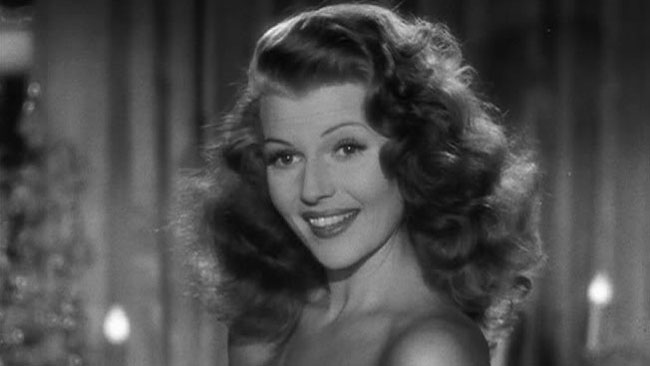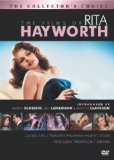| Reviews & Columns |
|
Reviews DVD TV on DVD Blu-ray 4K UHD International DVDs In Theaters Reviews by Studio Video Games Features Collector Series DVDs Easter Egg Database Interviews DVD Talk Radio Feature Articles Columns Anime Talk DVD Savant Horror DVDs The M.O.D. Squad Art House HD Talk Silent DVD
|
DVD Talk Forum |
|
|
| Resources |
|
DVD Price Search Customer Service #'s RCE Info Links |
|
Columns
|
|
|
Films of Rita Hayworth, The

Cover Girl (1944) is a bouncy musical starring Hayworth as Rusty, a showgirl who goes after an opportunity to be on the cover of Vanity Magazine's anniversary issue. Her dance hall boss and paramour Danny McGuire (Gene Kelly) is too proud to ask her to stay on at her nightclub gig once she's offered the magazine cover, so he sends her packing. Rusty goes on to become a Broadway star, on the verge of marrying a big-shot producer, when Danny returns for the inevitable reunion.
Cover Girl's story is formulaic, but the Kelly-directed dance sequences are just dazzling. Charles Vidor's crisp direction keeps us moving quickly past the more groan-inducing plot points, keeping the musical numbers snappy and fun, despite the fact that some of the songs lack staying power. Hayworth and Kelly are joined by Phil Silvers as Kelly's sidekick, and by outstanding Technicolor photography courtesy Allen M. Davey and Rudolph Maté.
Cover Girl's lasting reputation owes more to Kelly's genius than to Hayworth's star power, although her allure is on full display here; without her combination of beauty and vulnerability, the character dynamics in Cover Girl would be a drag.
Tonight and Every Night (1945) is a wartime "the show must go on" story, purporting to tell of a London theater that manages to maintain an uninterrupted performance schedule during the Blitz. Hayworth plays the hall's star performer, Rosalind Bruce, who, along with her fellow dancers, keeps a stiff upper lip throughout nights of bombing, putting on show after show and falling in love with a British pilot (Lee Bowman) to boot.
The film is memorable for its bold design, inventive musical numbers, and lush color photography. Directed by Victor Saville without a whole lot of concern for story or character, this is a vehicle for the film's visual team, including Rudolph Maté (DP, again) and production designers Lionel Banks, Stephen Goosen, and Rudolph Sternad, as well as costume designers Jean Louis and Marcel Vertès. The skeptical viewer will have a hard time accepting the flawlessness of this theater's purported productions and the richness of their design during the strictures of rationing, to say nothing of the presumed inability of the cast and crew to obtain new materials and equipment in bombarded London. But Tonight and Every Night is successful as a spectacle, helped immeasurably by the dancing of the great Marc Platt.
Gilda (1946) is one of the greatest, and most twisted, films in the noir catalog. Charles Vidor again directs Hayworth as the title character, whose creepy husband, Mundson (George Macready), operator of an upscale underground Buenos Aires casino, has just hired a hapless would-be grifter named Johnny Farrell (Glenn Ford) as the casino's new manager. Little does he know that Farrell and Gilda were once lovers, a relationship that scarred Johnny, and left him with feelings for Gilda that veer wildly, from disgust to lust.
Gilda's screenplay, by Marion Parsonnet, from a story by EA Ellington, is one of the most quietly bizarre and unpredictably grotesque in film history. The plot's twists and turns are all bound up with Farrell's perverse, extreme feelings of love and hate for Gilda, and with the twitchy dynamic tension that builds between Farrell and Mundson character.
Vidor's direction is oddly but deliberately paced, lingering here and there on strange moments with just the right sense of voyeuristic observation. The musical numbers are seductive. Rudolph Maté returns as cinematographer, and he tempers his elegant sensibility with a smart infusion of deep shadow. Able support is provided by the great Joseph Calleia as Detective Obregon, who investigates Mundson's criminal activities. Gilda is an unmitigated classic with great, strange depth of feeling - the tension between Hayworth and Ford is one of the most striking things in noir history.
Miss Sadie Thompson (1953) is a neutered adaptation of Maugham's story "Rain," previously filmed at least twice during the silent era, but more memorably as Rain (1932) with Joan Crawford. Rita Hayworth was an excellent choice for the remake, but the timing was poor. The early 1950s was a bad time for honesty in Hollywood cinema, and Miss Sadie Thompson's script is a good demonstration of an industry afraid of human nature.
In this adaptation, Maugham's prostitute is simply made into a woman with a shady past, and when she arrives in American-occupied Samoa, the Marines (who include Aldo Ray, Charles Bronson, and Rudy Bond) compete aggressively for her attention. The preacher who wants her sent away (Jose Ferrer) is not a shady creep in the way Walter Huston was in Rain - he's just some generic Puritanical authority figure. Thanks to the Production Code, the whole story has been made so vague, we're not really sure what the hell's going on. It's surprising anyone was inspired to adapt the material at all, under the circumstances. Miss Sadie Thompson does share one noteworthy aspect with the other films in this set: outstanding photography, in color, by Charles Lawton, Jr.
Salome (1953) is a perfunctory Biblical non-epic with a stage-bound look and a talented cast who mostly appear as if they would prefer to be elsewhere. Hayworth plays the temptress of the title, and Charles Laughton plays Herod with less deliciousness that we expect. Cedric Hardwicke, Judith Anderson, and Stewart Granger are also on hand to deliver stilted dialogue without much inflection; Anderson is the only one who offers any sense of drama - the others seem like they're mostly thinking about what they're going to have for lunch.
Director William Dieterle doesn't appear to have had a concept for the movie. He seems to have been relying upon star power and the familiarity of the storyline. Even the Dance of the Seven Veils has no real appeal - Hayworth is a capable dancer, but her movements look like they were designed and directed by Robby the Robot. Salome is one of the weakest of the '50s many religious adaptations.
The DVD
Image and Sound
The transfers in this set are all fantastic. Four of the five were shot in Technicolor; only Gilda is in black and white. The color pictures all look wonderful, bearing that special and peculiar unreal look only afforded by Technicolor. Gilda is clear as a bell. All five transfers show excellent contrast and detail, with virtually no compression artifacts. Miss Sadie Thompson probably looks the worst in the set, but it's not by much and likely due to the scarcity of "flat" prints, since it was (oddly enough) shot and generally distributed in 3D. Each picture has its original mono soundtrack, and these are generally very clear. Music comes across particularly well in Cover Girl and Tonight and Every Night.
Bonus Content
The first four films in the set come with video introductions by notable fans. Each runs about four minutes. Cover Girl's is by Baz Luhrmann, who also offers his thoughts on Gilda, while Patricia Clarkson introduces Tonight and Every Night and Miss Sadie Thompson. Martin Scorsese joins Luhrmann on the Gilda piece, which is longer than the others (sixteen minutes). Rounding out the special features is a commentary on Gilda by critic Richard Schickel. It's a decent, informative, if occasionally dry track.
Final Thoughts
Three very good films and two lackluster ones form a less-than-ideal tribute to the considerable appeal and talent of Rita Hayworth. A souped-up re-release of The Lady from Shanghai and her reunion with Glenn Ford in The Loves of Carmen - or better yet, Pal Joey, with Frank Sinatra - would have made this a much stronger set. However, Gilda is brilliant, and the two musicals hold their own. On balance, this set comes recommended.
|
| Popular Reviews |
| Sponsored Links |
|
|
| Sponsored Links |
|
|
| Release List | Reviews | Shop | Newsletter | Forum | DVD Giveaways | Blu-Ray | Advertise |
|
Copyright 2024 DVDTalk.com All Rights Reserved. Legal Info, Privacy Policy, Terms of Use,
Manage Preferences,
Your Privacy Choices | |||||||














